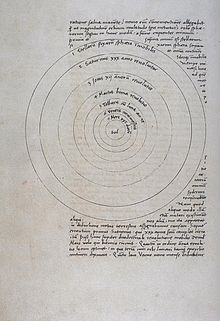

The autograph of Nicolaus Copernicus' De revolutionibus is a manuscript of six books of De revolutionibus orbium coelestium (1543) by Nicolaus Copernicus written between 1520 and 1541.[1] Since 1956, it is kept in the Jagiellonian Library in Kraków (signature 10,000).[2]
The autograph was handwritten by Nicolaus Copernicus in Latin and Greek, using humanistic cursive. The manuscript consists of 213 paper leaves sized 28 × 19 centimeters, two endpapers, and four protective cards. The binding of the manuscript dates back to the early 17th century and is made of cardboard glued with waste paper and a parchment document from the 16th century.[3]
It is a unique object on a global scale, inscribed in 1999 on the UNESCO Memory of the World list.[4] It is also the most valuable and famous autograph kept in the collections of the Jagiellonian Library of the Jagiellonian University, of which it has been the property since 1956.
The text of the autograph, which was first published in 1543 in Nuremberg in the first edition of De revolutionibus orbium coelestium, revolutionized the perception of the universe from a historical point of view and was a starting point for modern astronomy and science.[5]
- ^ "Nicholas Copernicus: "De revolutionibus"". pka.bj.uj.edu.pl (in Polish). Retrieved 2024-04-23.
- ^ "Poland- Nicolaus Copernicus's masterpiece "De revolutionibus libri sex." (ca 1520)" (PDF). Archived from the original (PDF) on 2011-07-08. Retrieved 2019-01-18.
- ^ Zathey (1972, p. 38)
- ^ "Nicolaus Copernicus' masterpiece "De revolutionibus libri sex"". unesco.org. Archived from the original on 2011-07-03. Retrieved 2013-11-17.
- ^ Hart (1996, p. 100)
© MMXXIII Rich X Search. We shall prevail. All rights reserved. Rich X Search
